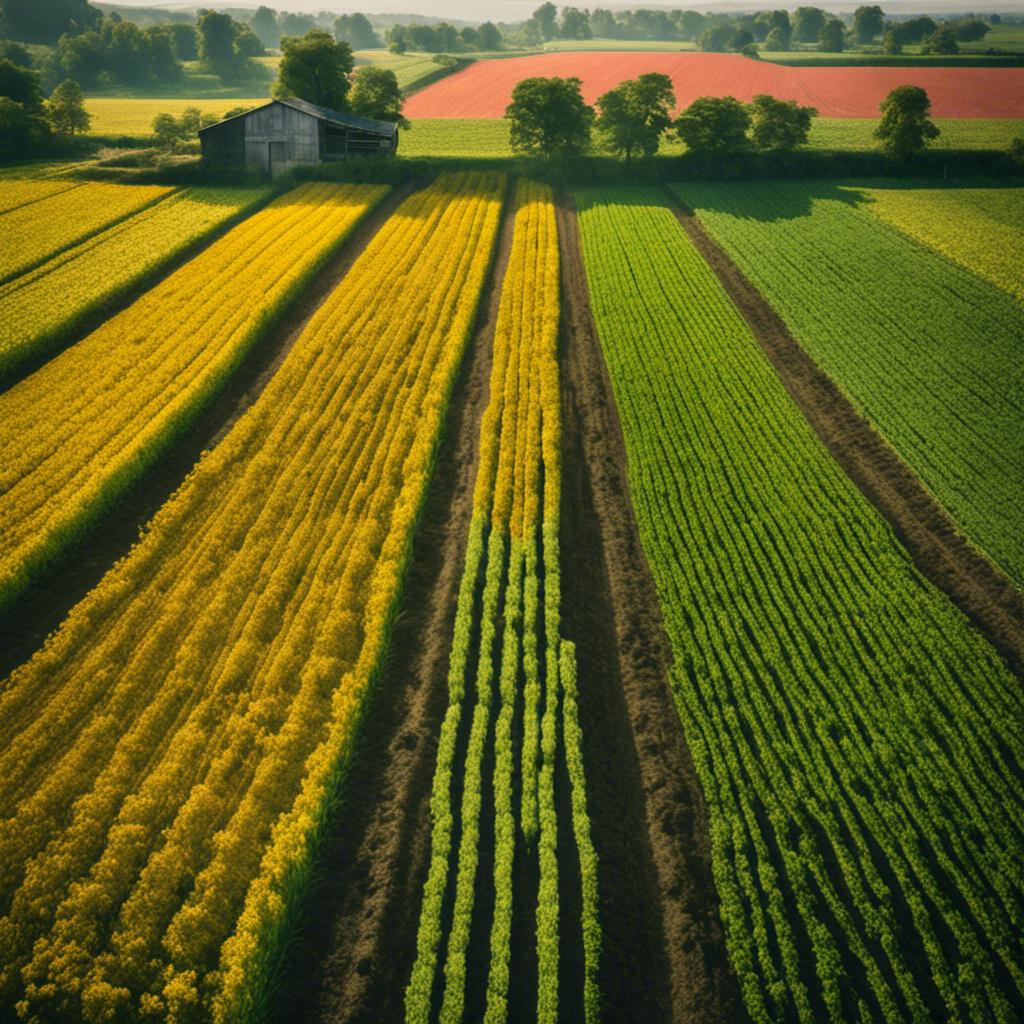As homesteaders, we face a unique set of obstacles that are directly tied to our isolated way of life and the abilities we have. Our existence, resembling strong limbs swaying in the wind, is molded by the demands of self-sufficient living.
In this article, we explore the impact of isolation on homesteading challenges and the role our skill set plays in navigating them. From the toil of hard labor to the unpredictability of weather, we delve into the intricacies of animal care and the importance of internet connectivity.
Join us as we uncover strategies for overcoming these hurdles and embracing the growth that comes with homesteading.
Key Takeaways
- Homesteading requires a diverse range of skills and knowledge in areas such as crop rotation, animal care, carpentry, and more.
- The isolation experienced in homesteading can make it difficult to access diverse crops, seeds, and agricultural expertise.
- Resourcefulness and self-sufficiency are crucial in overcoming challenges such as limited resources, changing weather conditions, and unexpected events.
- Homesteaders face physical challenges in performing manual labor, such as lifting heavy objects, tilling the soil, and caring for livestock.
Isolation: The Impact on Homesteading Challenges
We’ve found that the isolation of homesteading presents many unique challenges. One of these challenges is crop rotation. Without access to a diverse range of crops, it can be difficult to implement a successful crop rotation system. Crop rotation is important for maintaining soil health and preventing the build-up of pests and diseases.
In an isolated homesteading setting, it may be harder to acquire different types of seeds or plants for rotation. Additionally, pest management becomes a more challenging task. Without the assistance of nearby farmers or agricultural experts, homesteaders must rely on their own knowledge and skills to combat pests. This requires a deep understanding of pest behavior and effective organic pest control methods.
The isolation factor in homesteading emphasizes the need for self-sufficiency and resourcefulness in managing crop rotation and pest control.
The Role of Skill Set in Homesteading Challenges
Our skill set plays a crucial role in navigating the challenges of homesteading. As homesteaders, we rely heavily on our skills and knowledge to sustain ourselves and our families. Here are some key aspects of our skill set that help us tackle the unique challenges of homesteading:
-
Resourcefulness: Being able to make the most out of limited resources is essential. From repurposing materials to finding creative solutions, our resourcefulness helps us overcome obstacles.
-
Self-sufficiency: Homesteading requires us to be self-reliant. Our ability to grow our own food, raise livestock, and maintain our homestead allows us to sustain ourselves without depending on external sources.
-
Adaptability: The homesteading lifestyle is ever-changing, and we need to adapt to various situations. Weather conditions, market fluctuations, and unexpected events require us to be flexible and adaptable.
-
Continuous learning: As homesteaders, we’re constantly learning new skills and techniques. From building structures to preserving food, our willingness to learn ensures our homestead thrives.
While our skill set is crucial, the role of community support can’t be underestimated. The psychological impact of having a supportive community is immense. Sharing knowledge, resources, and experiences with fellow homesteaders helps alleviate the challenges and provides a sense of belonging. It also serves as a reminder that we aren’t alone in this journey.
Together, we can achieve sustainable and fulfilling lives on our homesteads.
Hard Manual Labor: A Unique Challenge for Homesteaders
Hard manual labor is a unique challenge for homesteaders, as it requires a significant amount of physical strain and exhaustion. From clearing land to building structures, the physical demands of homesteading can be overwhelming.
Additionally, homesteaders need to possess specialized knowledge in various areas such as construction, farming, and animal care in order to effectively tackle the tasks at hand.
Physical Strain and Exhaustion
We’re constantly pushing through physical strain and exhaustion while performing the demanding manual labor required on the homestead. It’s no secret that the physical endurance required for homesteading is immense. From sunrise to sunset, we find ourselves engaged in repetitive tasks that test our stamina and resilience.
Here are some of the challenges we face on a daily basis:
- Lifting heavy objects: Whether it’s hauling buckets of water or moving bales of hay, our muscles are always put to the test.
- Digging and tilling the land: Preparing the soil for planting requires hours of bending, digging, and shoveling, leaving us physically drained.
- Chopping wood: Providing heat for our homes means spending hours swinging an axe, which can be incredibly tiring.
- Animal care: Feeding, watering, and tending to livestock demands constant physical effort, especially during extreme weather conditions.
Despite the physical strain and exhaustion, we find solace in knowing that our hard work contributes to a sustainable and self-sufficient lifestyle.
Need for Specialized Knowledge
Navigating the unique challenges of homesteading requires acquiring specialized knowledge and continuously honing our skills. As homesteaders, we understand the importance of being self-reliant and self-sufficient. We must possess a diverse range of specialized skills to effectively manage our homesteads. From animal husbandry and crop rotation to carpentry and food preservation, our expertise spans various areas. The acquisition of knowledge is a constant pursuit, as we seek to stay updated on the latest techniques and technologies. This knowledge not only helps us overcome the challenges we face but also allows us to thrive in our homesteading endeavors.
To illustrate the breadth of specialized skills we require, consider the following table:
| Skills | Examples | Importance |
|---|---|---|
| Animal Husbandry | Raising chickens, goats, etc. | Essential |
| Organic Gardening | Crop rotation, pest control | Vital |
| Sustainable Energy | Solar panel installation, wind turbine maintenance | Crucial |
| Food Preservation | Canning, drying, fermenting | Necessary |
| Carpentry | Building structures, repairs | Important |
This table represents just a glimpse of the vast array of skills we must possess and continuously improve upon. By acquiring specialized knowledge and honing our skills, we are better equipped to face the unique challenges of homesteading.
Weather Vulnerability: How It Affects Homesteading
Weather vulnerability is a significant challenge that affects homesteading in various ways.
Firstly, crop survival during storms can be a major concern, as heavy rains, strong winds, or hail can damage or destroy crops that homesteaders rely on for food and income.
Secondly, limited access to resources during extreme weather events, such as snowstorms or floods, can make it difficult for homesteaders to obtain supplies or seek help in emergency situations.
Lastly, weather can impact the care of livestock, as extreme temperatures or severe weather conditions can affect their health and well-being.
Crop Survival During Storms
As homesteaders, we understand the challenges of crop survival during storms and the impact it can have on our self-sufficiency. It’s crucial for us to manage our crops effectively to minimize the risk of damage caused by extreme weather conditions. Here are some key points to consider:
-
Crop selection: Choosing resilient and weather-resistant crop varieties can greatly enhance our chances of survival during storms.
-
Sheltered cultivation: Utilizing greenhouses or high tunnels can provide protection against strong winds and heavy rainfall.
-
Soil erosion prevention: Implementing proper soil management techniques, such as cover cropping, mulching, and terracing, can help prevent soil erosion during storms.
-
Emergency preparedness: Developing an emergency plan, including strategies for securing crops and equipment, will enable us to respond effectively when severe weather strikes.
Limited Access to Resources
How can we ensure our self-sufficiency on the homestead with limited access to resources and the vulnerability of our crops to weather conditions? This is a crucial question that we must address as homesteaders. Limited access to supplies and a lack of infrastructure pose unique challenges for us. To overcome these obstacles, we need to rely on our skills and resourcefulness.
One way to ensure self-sufficiency is by diversifying our crops. By growing a variety of fruits, vegetables, and grains, we can reduce the risk of a complete crop failure due to adverse weather conditions. Additionally, we can establish a system of crop rotation to optimize soil fertility and minimize the impact of pests and diseases.
Another strategy is to invest in alternative methods of food production, such as aquaponics or hydroponics. These systems allow us to grow crops indoors, minimizing the reliance on external resources and overcoming the limitations of our infrastructure.
Here is an example table to illustrate the importance of diversification:
| Crop Type | Advantages |
|---|---|
| Fruit Trees | Long-term yield, low maintenance |
| Root Vegetables | High nutritional value, storage capability |
| Grains | Staple food, versatile |
Impact on Livestock Care
To overcome the challenges of weather vulnerability, we must carefully consider the impact on livestock care and develop strategies to ensure their well-being. Livestock breeding and animal health are crucial aspects of our discussions. Here are some key points to consider:
-
Shelter: Providing adequate shelter is essential to protect livestock from extreme weather conditions such as heatwaves, storms, and cold snaps. This can be achieved through well-designed barns, sheds, or natural windbreaks.
-
Nutrition: Weather challenges can impact the availability of pasture and forage. It’s important to have a plan in place to supplement feed during times of scarcity, ensuring the animals receive proper nutrition.
-
Water management: Extreme weather events can disrupt access to clean water sources. Implementing measures such as rainwater collection systems and regular monitoring of water quality are necessary to maintain animal hydration.
-
Disease prevention: Weather can influence the spread of diseases, such as heat stress or infections caused by wet conditions. Regular vaccination, proper hygiene practices, and monitoring animal health are vital to minimize the impact of weather-related illnesses.
Animal Care: Challenges in Homesteading
While we face various challenges in homesteading, caring for animals remains one of the most demanding aspects.
Animal health and predator protection are crucial factors that require constant attention and effort. Ensuring the well-being of our livestock is essential for their overall productivity and longevity. This involves regular monitoring of their health, providing proper nutrition, and promptly addressing any medical issues that may arise.
Additionally, protecting our animals from predators is a constant concern. Implementing appropriate fencing, secure enclosures, and deterrents like motion sensor lights or guard animals are necessary precautions. Predators pose a real threat to the safety and well-being of our animals, and we must remain vigilant in our efforts to protect them.
Overall, animal care in homesteading demands a high level of dedication and knowledge to ensure the health and safety of our livestock.
Lack of Amenities: Unique Hurdles for Homesteaders
We have encountered several unique hurdles as homesteaders due to the lack of amenities, such as limited access to electricity and running water. Living off the grid has its challenges, but it also brings a sense of freedom and self-sufficiency. Here are some of the obstacles we face:
-
Energy management: With limited access to electricity, we rely on alternative energy sources like solar panels or wind turbines. It requires careful planning and conservation to meet our energy needs.
-
Water conservation: Without running water, we’ve to be mindful of our water usage. Collecting rainwater and using it efficiently becomes essential for our daily needs, as well as for irrigation and livestock.
-
Waste management: Without conventional waste disposal systems, we’ve to find creative ways to handle our waste. Composting, recycling, and reusing become integral parts of our lifestyle.
-
Self-reliance: Limited resources mean we’ve to develop a diverse skill set to meet our needs. From growing our food to repairing equipment, we become more self-reliant and resourceful.
Living off the grid may have its challenges, but it also allows us to experience a simpler, more sustainable way of life.
Variable Income: The Financial Challenges of Homesteading
Managing a variable income can be a challenge for homesteaders, but with careful budgeting and diversification, we can overcome these financial obstacles. Financial planning becomes crucial for creating stability in our income streams.
Homesteading often involves multiple sources of income, such as selling produce, livestock, or handmade goods. However, the unpredictability of these markets can make it difficult to rely on a consistent flow of money. To tackle this issue, we must develop a comprehensive financial plan that considers both short-term and long-term goals.
This plan should involve setting aside emergency funds, tracking expenses, and creating a budget that allows for flexibility. Diversification is also key to stabilizing income. By exploring different avenues, such as renting out land, offering workshops, or creating value-added products, we can mitigate the risks associated with a variable income.
Ultimately, financial stability in homesteading is attainable through careful planning and adaptability.
Dependence on Skill Set: How It Shapes Homesteading Challenges
Navigating the unique challenges of homesteading heavily relies on our skill set and how it shapes our ability to overcome obstacles. Homesteading requires hard work and physical endurance, as we face various tasks that demand our physical strength and stamina. Here are four ways our skill set influences the challenges of homesteading:
-
Building and repairs: Our ability to construct and fix structures on the homestead is crucial. From repairing fences to building barns, our skill set determines how efficiently we can tackle these projects.
-
Gardening and farming: Growing our own food is a central aspect of homesteading. Our knowledge of planting, nurturing crops, and tending to livestock directly impacts our success in achieving self-sufficiency.
-
Problem-solving: Homesteading often presents unexpected challenges. Our skill set in problem-solving allows us to find creative solutions when faced with issues like equipment breakdowns or pest infestations.
-
Resource management: Homesteading requires us to be efficient with our resources. Our skill set in budgeting, conservation, and sustainable practices helps us make the most of what we have.
Self-Reliance: The Key to Overcoming Homesteading Challenges
Self-reliance is crucial for overcoming the unique challenges of homesteading. By diversifying our skill set, we become more independent and capable of handling various tasks that arise on the homestead.
Additionally, building a community of like-minded individuals can help us overcome the isolation that often comes with homesteading, providing support, knowledge sharing, and a sense of belonging.
Skill Diversification for Independence
We’re all about broadening our set of skills in order to achieve independence on the homestead. Skill development plays a crucial role in our journey towards self-sustainability. By acquiring a diverse range of abilities, we can tackle the unique challenges that come with homesteading.
Here are a few skills that are essential for our self-reliance:
-
Gardening: Growing our own food not only provides us with fresh produce but also reduces our dependence on external sources.
-
Animal husbandry: Raising livestock allows us to have a sustainable source of meat, milk, and eggs.
-
Carpentry: Being able to build and repair structures on our homestead ensures that we can maintain our living spaces and infrastructure.
-
Energy production: Developing skills in renewable energy, such as solar panel installation and maintenance, helps us reduce our reliance on traditional power sources.
Overcoming Isolation Through Community
Living in a tight-knit community allows us to overcome isolation and build connections, creating a support network that helps us overcome the challenges of homesteading. Homesteading, with its reliance on self-sufficiency and skill, can often lead to feelings of loneliness and isolation.
However, by actively engaging with our community and building a support system, we can overcome these challenges and find solace in the company of others who share our lifestyle. Building community support is essential in homesteading as it provides a platform for sharing knowledge, experiences, and resources. It allows us to learn from each other’s mistakes, offer advice, and lend a helping hand when needed.
Through community, we can cultivate a sense of belonging and camaraderie, alleviating the feelings of isolation and creating a network of support that strengthens our ability to thrive in the homesteading lifestyle.
Home Maintenance: Challenges for Homesteaders
One of the biggest challenges we face as homesteaders is keeping up with the numerous home maintenance tasks. From home repairs to equipment maintenance, there’s always something that needs attention on the homestead.
Here are a few specific challenges we often encounter:
-
Plumbing issues: With older homes and a reliance on well water, we frequently find ourselves dealing with leaky pipes, clogged drains, and malfunctioning water pumps.
-
Roof maintenance: Our homes are subjected to harsh weather conditions, and regular roof inspections and repairs are necessary to protect our property from leaks and structural damage.
-
Electrical problems: As we rely on various electrical equipment for our daily tasks, electrical issues can disrupt our routines and pose safety risks.
-
Equipment upkeep: From tractors to generators, our homestead relies heavily on equipment. Regular maintenance and repairs are essential to keep everything running smoothly.
Balancing these maintenance tasks with our other responsibilities can be overwhelming at times, but it’s a necessary part of homesteading life to ensure that our homes and equipment are in good working order.
Internet Connectivity: Its Importance in Homesteading Challenges
Internet connectivity plays a crucial role in homesteading challenges.
As homesteaders, we rely on the internet to overcome the limitations of rural internet access, allowing us to communicate with the outside world and access valuable resources.
Without a reliable internet connection, we face obstacles in staying connected, finding information, and maintaining self-sufficiency on our homesteads.
Rural Internet Limitations
We have experienced firsthand the frustratingly slow speeds and unreliable connection of rural internet, limiting our ability to efficiently complete tasks and access important resources. Living in a rural area, we rely heavily on the internet for various purposes, such as work, education, and entertainment. However, the lack of adequate rural infrastructure and limited technological advancements in these areas pose significant challenges for us.
Some of the issues we face include:
- Slow internet speeds that hinder productivity and efficiency.
- Unreliable connection that disrupts online activities.
- Difficulty in accessing online resources and services.
- Limited options for internet service providers, leading to a lack of competition and higher costs.
These limitations not only affect our daily lives but also hinder the economic development and growth of rural communities. It’s crucial for policymakers and stakeholders to address these challenges and invest in improving rural internet connectivity to bridge the digital divide and promote equal opportunities for all.
Communication Obstacles Faced
Experiencing communication obstacles in our homesteading journey has highlighted the significance of effective connection and collaboration in overcoming challenges. Living in a remote location comes with its own set of communication barriers, such as limited cell service and unreliable internet access. These obstacles can hinder our ability to stay connected with the outside world and collaborate with other homesteaders. To illustrate the impact of communication barriers, let’s consider the following table:
| Communication Barriers | Challenges |
|---|---|
| Limited cell service | Difficulty making and receiving calls |
| Unreliable internet access | Inability to access online resources and communicate via email |
These barriers can greatly impede our ability to seek advice, share knowledge, and learn from others in the homesteading community. However, by actively seeking alternative communication methods, such as satellite internet or two-way radios, we can mitigate these challenges and continue to foster effective collaboration.
The impact of these communication obstacles on self-sufficiency will be further explored in the subsequent section.
Impact on Self-Sufficiency
Given the limitations of our remote location, relying solely on unreliable internet access and limited cell service has had a significant impact on our self-sufficiency. Without a reliable connection, we face challenges in managing our resources effectively.
-
Communication: Lack of reliable internet and cell service hinders our ability to coordinate with suppliers, contractors, and other homesteaders in the area.
-
Information: Access to online resources for guidance and knowledge is limited, making it difficult to stay updated on best practices and new techniques.
-
Emergency Preparedness: In the event of an emergency, we rely heavily on communication to seek help or assistance, making our self-sufficiency vulnerable.
-
Market Access: Limited access to the internet restricts our ability to market our products or find potential buyers, affecting our overall self-sufficiency and financial stability.
To overcome these challenges, we prioritize alternative communication methods, such as two-way radios or satellite phones, and engage in local networking to stay connected and informed. Resource management becomes crucial, as we must ensure efficient utilization of limited supplies and rely on our own skills and knowledge to maintain self-sufficiency in our remote homesteading lifestyle.
Overcoming Challenges: Strategies for Homesteaders
Our primary strategy for overcoming challenges as homesteaders is to diversify our skill set and adapt to the isolation of our lifestyle. In order to achieve self-sufficiency, we believe it’s essential to possess a wide range of skills that are applicable to various aspects of homesteading. From farming and animal husbandry to construction and food preservation, we strive to become proficient in these areas to ensure our ability to meet our own needs.
Additionally, building a support network within the homesteading community is crucial. Through networking, we can exchange knowledge and resources, seek advice, and even collaborate on projects. It helps alleviate the sense of isolation that comes with the homesteading lifestyle and provides emotional and practical support when faced with challenges.
Planning and Preparation: Mitigating Homesteading Challenges
We are actively working on developing a comprehensive plan to mitigate the challenges that arise during the process of homesteading. Homesteading presents unique challenges that require careful planning and resource management. To ensure success and overcome these challenges, we’re implementing various planning strategies.
-
Establishing a detailed timeline: We’re mapping out specific tasks and deadlines to ensure efficient use of time and resources.
-
Conducting thorough research: We’re actively gathering information on various aspects of homesteading, such as sustainable farming practices and off-grid living techniques.
-
Building a strong support network: We’re connecting with experienced homesteaders and local communities to seek guidance, advice, and assistance when needed.
-
Creating contingency plans: We’re preparing for unexpected events by developing backup plans and alternative solutions to minimize disruptions to our homesteading journey.
Through these planning strategies and effective resource management, we aim to navigate the challenges of homesteading and create a sustainable and self-reliant lifestyle.
Learning and Growth: Navigating the Unique Challenges of Homesteading
As we face the unique challenges of homesteading, we’re constantly learning and growing to navigate them successfully. Homesteading requires a diverse set of skills, from gardening and animal husbandry to carpentry and food preservation. The isolation and self-reliance that come with homesteading can present both learning opportunities and personal development.
By being solely responsible for our own sustenance, we’re forced to expand our knowledge and improve our skill sets. This can lead to personal growth as we gain confidence in our abilities and become more self-sufficient. The challenges of homesteading also provide opportunities for continuous learning, as we encounter new obstacles and find innovative solutions.
Overall, the unique challenges of homesteading foster a culture of constant learning and personal development, helping us to thrive in this lifestyle.
Frequently Asked Questions
How Does Isolation Impact the Mental Health of Homesteaders?
Isolation can have a significant impact on the mental health of homesteaders. The lack of social interaction can lead to feelings of loneliness and isolation. However, individuals often develop coping mechanisms to combat these challenges.
What Are the Most Essential Skills Needed for Successful Homesteading?
To successfully homestead, we need a variety of essential skills such as gardening, animal husbandry, carpentry, and food preservation. These skills help us overcome the self-sufficiency challenges and ensure our independence in remote and isolated locations.
How Do Homesteaders Manage the Physical Strains of Hard Manual Labor?
We manage the physical strains of hard manual labor on the homestead by incorporating ergonomic techniques and utilizing support systems. These strategies help us prevent injuries and maintain our physical well-being while working on various tasks.
What Strategies Can Homesteaders Use to Protect Their Homestead From Extreme Weather Conditions?
To protect our homestead from extreme weather conditions, we rely on strategies such as reinforcing our infrastructure, using alternative energy sources like solar panels, and implementing proper insulation. These measures help us maintain a safe and sustainable environment.
How Do Homesteaders Handle the Challenges of Caring for Animals in a Self-Reliant Lifestyle?
When it comes to caring for animals in a self-reliant lifestyle, we prioritize animal nutrition and healthcare. We ensure they receive proper nourishment and access to veterinary care to keep them healthy and thriving.
Conclusion
In the vast expanse of homesteading, isolation and dependence on skill set create a tapestry of unique challenges.
Like a lone seed in a barren land, homesteaders face the daunting task of navigating the hardships that come with self-sufficiency.
From the relentless toil of hard manual labor to the unpredictable dance with weather vulnerabilities, homesteading demands resilience.
Yet, armed with careful planning, continuous learning, and a strong spirit, these challenges can be overcome, unveiling a rewarding journey of growth and self-reliance.











